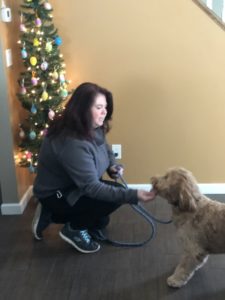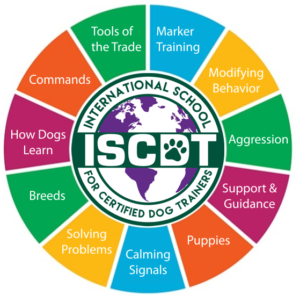One of the most upsetting situations for a family with a newly adopted dog is learning that the dog fears one or more family members. Very often this fear is not realized until after the dog is in the home for a week or two. By that time the rest of the family has formed a bond with this dog, and you feel like an outsider.
This is a tough reality for someone who fantasized that their dog would enjoy riding shotgun in their car, playing ball and snuggling with them at night. Instead, the dog hides or shakes every time they share space with that person. This is a distressing situation and we do feel for you. It truly is not you. It is about your dog and what she is feeling. Let’s look at this new arrangement from the dog’s point of view. Before you adopted your dog, she may have:
suffered a lousy past and struggles to trust certain groups of people,
spent her entire life with someone she truly loved. Now this life change is sad or confusing,
lacked proper socialization with different groups of people.
Even if your dog’s old life was lousy, it was all she knew. Since losing that home, she’s spent time in different shelter environments, and now she is thrust into another new environment with a person who scares the bejeebers out of her.
The dog didn’t come into your home with a plan to banish you. She wants to feel secure and safe in her new environment, she just cannot control her fear. Often we exacerbate that fear by trying too hard and expecting quick results. Dogs sense our frustration and we often intimidate dogs with our body language. We also try to rehabilitate them too quickly. You cannot rehabilitate fear on your time schedule. Overcoming fear takes time – a lot of time.
Below are 10 tips to help you with this very slow process. In most cases it takes months (sometimes years) of rehabilitation. Every situation is different. Some owners will move through these tips effortlessly. Others may find some of these tips too scary for their dog. Pick the tips you feel are best for your situation. If you are unsure, contact a qualified dog trainer.
Ignore the dog: People believe that they should force interaction with the dog by offering food. When the dog musters enough courage to snatch food from your hand, the person always goes in for the pet. This terrifies the dog. Refrain from using this thwarted idea. Instead, we want you to ignore the dog. Avoid eye contact, avoid petting the dog, avoid talking to the dog. Just pretend she does not exist. When the dog comes over to smell you, continue to ignore her. Even if she sits by your side or lays at your feet, ignore the dog. Forcing interaction before she is ready, tells her it is not safe to come near you. When she is ready for interaction, her signals will be very clear. When that time comes, refrain from showing excitement. Instead, remain aloof and simply pet her on the neck or chest. Never over the head or on the face. After a brief time, stop petting her and once again ignore. In time, she will crave your attention.
Obedience training: It is common for dog owners to coddle their new rescue dog rather than provide structure. This is especially true if they believe the dog suffered a miserable past. Dogs need a leader who will guide them through life. A dog without a strong leader makes bad choices and can spiral into extreme anxiety. After a brief settling in period, begin obedience training. Start with simple commands to increase the dog’s motivation and self confidence then gradually add more complex commands. Dogs respect family members who guide them. Structure increases confidence levels and helps decrease anxiety.
Feed your dog: Rather than tossing kibble in a large bowl and leaving the food down all day, create a feeding schedule for your dog. In the morning, prepare the food, place it on the floor and walk away (don’t force the dog to interact with you). If your dog does not eat it after 25 minutes, pick up the bowl of food. Repeat this process again for dinner (even if the dog finishes breakfast, offer the food twice a day).
Bring the fun: Participate in activities your dog enjoys. If your dog loves going for walks, enjoys car rides, cannot wait for her afternoon bone or is thrilled to go to doggie daycare, be the one in charge of those activities. We have witnessed frightened dogs push past fear in order to engage in an activity they enjoy. Don’t make a production over you being the person connecting her to her favorite activity.
“Look who’s bringing you to the dog park. ME! No one else in the family brings you there. Only I do. I am so much fun and so wonderful”
Your energy, eye contact and body language will likely just stress her out. Our advice, ‘Show, don’t tell’. Bring her without the fanfare. The repetition of you bringing her to a fun location is enough to help her realize that time with you equals fun.
Be consistent: This is an important tip. Dogs are creatures of habit. In order for you to gain your dog’s trust and increase the bond, you must consistently meet your dog’s daily needs. You cannot expect to form a relationship with your dog if you continuously hand her off to someone else. Walking or feeding your dog once in a while is not benefiting either of you. Pick tasks that fit into your daily routine and make sure you complete those tasks daily.
Learn canine body language. When you understand your dog’s body language and calming signals, it helps you avoid behavior that causes discomfort for your dog. It can also drastically reduce the chances of a dog bite. We suggest you read On Talking Terms with Dogs: Calming Signals by Turid Rugaas.
Stay down low: Imagine you are sitting on a bench in the park, reading a book. Someone walks up and stands uncomfortably close, looms over you and starts a conversation. They may even place a hand on the back of your bench. Their body language will likely alarm you and force you to move away or stand up. You may even lash out at them. Now you know how dogs feel. They meet one another by smelling the other’s butt. Yet, when we interact with dogs, we walk straight up to them, look them in the eye, bend at the waist and extend our hand. Creepy human alert! Instead of always looming over your dog, sit on the floor. If your dog shows signs that she wants you to pet her, keep your hands low. Pet her neck or chest. Avoid petting over the head or the face.
Treat Whisperer: This should never be the first step in bonding with your dog. This is a more advanced activity. It may take months, if not years, to get this far. That said, if this activity does not cause stress for your dog, you can try either of these options. Option 1: When the dog comes near you (a safe distance for the dog), casually drop food on the floor. While she eats, quietly say “good girl” (no fanfare or jazz hands here). Don’t pet the dog, simply step away. When she looks at you or shows interest, drop more food. Avoid eye contact and conversing with your dog. We want your dog to reap the benefits of sharing space with you without the fear of too much interaction. This works better when the dog is hungry. If your dog does not love her kibble, then practice this activity with a high-value treat (freeze-dried dog treats, cheese, small hot dog pieces, hamburger, chicken, etc.). Option 2. Sitting on the floor and angling your body so you are not looking straight at your dog, place food in your hand (keep hand low) and let the dog eat the food out of your hand. Softly praise the dog, “good” when she eats. Keeping your arms low and relaxed, refill your hand with dog food or a special treat. At first your dog may be leary and it may take several minutes to approach your hand. Avoid eye contact, keep your praise flat, avoid quick movements and do not attempt to pet your dog. Never force an unwilling dog to eat from your hand. Again, this is not something that should be exercised with a new or extreme fearful dog. This is an activity you can practice after your dog shows signs of comfort and trust. It may take weeks, months or years to get to this point. Only your dog can decide when she is comfortable to participate in this activity.
Quiet space: Some dogs prefer to hide in another part of the house, away from everyone, when the “scary” family member is home. We prefer the dog not hide. It benefits her to learn to share the space with the entire family. Cut off access to rooms your dog hides in when the family is home. Instead, include a safe place in the gathering space. Move her crate or dog bed to a corner of the room, away from the entryway, where foot traffic is the heaviest. Make a rule that no one interacts with the dog when she is in that spot. That means no one lays with the dog, pets her, talks to her, feeds her or interacts with her in any way. Your dog needs a safe place where she can unwind and relax without the fear of being bothered. Everyone should ignore the dog when she is in her safe place.
Patience: The most important tip on this list is patience. We feel for you. No one wants their dog to fear them. There will be times that your attempts seem hopeless. Your patience and continued effort to ease your dog’s fear is the most profound form of love you can give to an animal. Who knows, you may end up forming the strongest bond with this dog. It will take time — a lot of time. Have patience.
Featured Image Photo Credit: Simone Dalmeri on Unsplash
Our 18 lesson, online program is a hands-on program where students are required to work with dogs. Skill and ability is determined through a series of videos submitted to the school.Students are also responsible for written homework assignments. We also offer a 2-week and 4-month in-person internship. To learn more about the courses we offer, visit ISCDT.com




